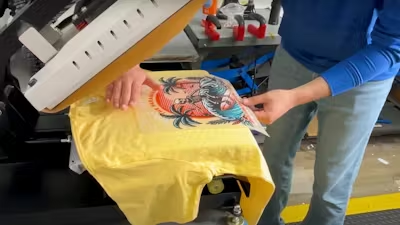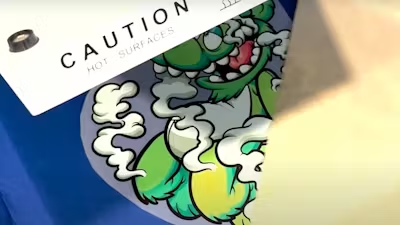You've just finished pressing your latest DTF transfer onto a t-shirt, excited to see your design come to life. But as you peel back the transfer film, your heart sinks-there's an unsightly scorch mark on the fabric. If this scenario sounds familiar, you're not alone. Scorching has always been a fairly common issue with any kind of heat transfer printing. However, if you follow our expert advice, you can avoid it entirely.
In this guide, we explore the details of heat-pressing DTF transfers and focus on preventing scorch marks. Whether you're using a heat press machine, a Cricut, or even a household iron, we cover essential tips and techniques to help you achieve flawless transfers every time. From understanding the science behind scorching to mastering temperature control and pressure application, you'll learn everything you need to keep your fabrics pristine while creating stunning custom apparel.
Table of Contents
- What is Scorching?
- Primary Reasons for Scorching
- Tips For Avoiding Scorching
- Best Fabrics For Heat Pressing
- Worst Fabrics for Heat Pressing
- How to Fix Mild Scorching
- Conclusion

What is scorching?
Scorching occurs when fabric is exposed to excessive heat, causing discoloration or damage to the material. In the context of heat pressing, scorch marks appear as brownish or yellowish discolorations on the fabric, often in the shape of the heat press platen or iron. These marks are essentially localized areas where the fabric fibers have begun to burn or melt due to overexposure to heat.
For those pressing DTF transfers at home or in a small business, it's crucial to understand the difference between minor heat-related discoloration and serious scorching. Slight discoloration of the heat-pressed area is sometimes normal and may disappear as the garment cools or after washing. This temporary effect is often seen in natural fibers like cotton.
However, more severe scorching, especially on delicate or synthetic fabrics, can result in permanent damage. We aim to prevent this type of scorching, as it can ruin garments and waste time and materials.
Primary reasons for scorching
Understanding the main causes of scorching is the first step in prevention. Here are the primary culprits:
- Temperature too high: Excessive heat is the most common cause of scorching. When the temperature exceeds the fabric's heat tolerance, it can lead to burning or melting of the fibers.
- Too much pressure: Applying too much pressure can intensify the heat transfer to the fabric, potentially causing scorching even at appropriate temperatures.
- Pressing for too long: Extended exposure to heat, even at the correct temperature, can lead to scorching. Every second counts when it comes to heat pressing.
- Not using a protective cover sheet: A cover sheet acts as a barrier between the heat source and the fabric, helping to distribute heat evenly and protect against direct contact with the hot surface.
-
Delicate fabric not suitable for heat pressing: Some fabrics, particularly synthetic blends or delicate materials, have low heat tolerance and are more prone to scorching.

Tips for avoiding scorching
Preventing scorch marks is crucial for producing high-quality DTF transfers. Here are some essential tips to help you avoid this common issue:
- Use the right temperature: For DTF transfers, we recommend starting at 310°F (154°C). However, you can experiment with temperatures as low as 280°F (138°C) for more delicate fabrics. Always refer to the manufacturer's guidelines for both your transfer film and the fabric you're using.
- Apply appropriate pressure: Start with moderate to high pressure for DTF transfers. If you're experiencing scorching, try reducing the pressure slightly. Remember that too little pressure can result in poor adhesion, so find the right balance through testing.
- Time it right: We recommend pressing for 15 seconds for optimal results with DTF transfers. In some cases, you can reduce this to as low as 10 seconds. Use a timer to ensure consistency and avoid over-pressing.
- Use a protective cover sheet: Always place a protective sheet, like our Protective Guard Sheets, between your heat press and the garment. This helps distribute heat evenly and protects the fabric from direct contact with the hot surface.
- Use an application pad: Application pads are thicker than standard protective guard sheets and can provide better insulation. Place a thin, stretchy, rubbery application pad over the transfer before pressing. This extra layer helps distribute heat more evenly and can significantly reduce the risk of scorching, especially on delicate or heat-sensitive fabrics.
- Use heat press pillows: Place heat press pillows inside garments when pressing over uneven surfaces like collars or pockets. They help distribute pressure evenly, prevent scorching on raised areas, and soften platen edges. Remember to adjust your pressure settings to account for the pillow's thickness.
- Test, test, test: Before committing to a full production run, always test your settings on a sample of the same fabric you'll be using. This allows you to fine-tune your temperature, pressure, and time settings without risking valuable materials.
- Invest in a quality heat press: A reliable heat press with accurate temperature control and even pressure distribution can significantly reduce the risk of scorching. Cheaper presses may have hot spots or inaccurate temperature readings.
- Consider fabric thickness: Adjust your settings based on the thickness of the fabric. Thinner fabrics may require lower temperatures or shorter pressing times to avoid scorching. Learn more about fabrics and blank apparel at Ninja University.
- For Cricut users: If using a Cricut EasyPress, follow the same principles of temperature, time, and pressure control. However, be extra cautious as these devices may not distribute heat as evenly as a professional heat press.
- For iron users: When using a household iron, opt for a lower temperature setting and increase pressing time if needed. Move the iron slowly and apply firm, even pressure. Use a pressing cloth for added protection against scorching.
-
Maintain your equipment: Regularly clean your heat press platen and check for any uneven surfaces that could cause hot spots. Well-maintained equipment produces more consistent results.
Remember: the key to avoiding scorching is finding the right balance of temperature, pressure, and time for your specific combination of transfer material and fabric. Don't be afraid to experiment, and keep detailed notes of your successful settings for future reference.
How to fix mild scorching
While prevention is always the best approach, sometimes you might end up with a slightly discolored square shape after pressing. Here's a method to help minimize the appearance of mild scorching:
- Use a handheld heat press (like a Cricut EasyPress Mini) or an iron.
- Start with a medium heat setting and increase as needed.
- Gently press the edges of the discolored square in a tight circular motion.
This technique helps blend the edges of the scorched lines into the rest of the garment, making them less noticeable. Remember, this is an extra step to be used only if you've made a mistake. The goal is always to prevent scorching in the first place by following the tips outlined earlier in this guide.

Best fabrics for heat pressing
While DTF transfers can work on a variety of materials, some fabrics are particularly well-suited for heat pressing. Here's a list of the best options and why they work so well:
- 100% Cotton: Cotton is the gold standard for heat pressing. It can withstand high temperatures, absorbs ink well, and produces vibrant, long-lasting results. Its natural fibers also allow for good breathability in the finished product. Learn about the differences between polyester vs. cotton.
- Cotton-Polyester Blends (50/50 or 60/40): These blends offer a good balance between the heat resistance of cotton and the durability of polyester. They're less prone to shrinkage than 100% cotton and still provide excellent print quality. Learn more about blended fabrics.
- Canvas: This sturdy fabric is great for heat pressing, especially for items like tote bags or shoes. Its tight weave provides an excellent surface for detailed designs.
- Denim: Denim's tough nature makes it suitable for heat pressing. It can withstand high temperatures and pressure, making it ideal for creating custom jean jackets or pants.
- Twill: Often used in caps and workwear, twill is another fabric that handles heat pressing well. Its diagonal weave provides an interesting texture that can enhance certain designs.
- Polyester: While it requires more careful temperature control, polyester is excellent for heat pressing due to its durability and color retention properties. It's especially good for moisture-wicking athletic wear.
-
Nylon: Nylon can be heat-pressed well, but it requires lower temperatures. Due to its durability and water-resistant properties, it's often used for lightweight jackets and sportswear.
Even with these "best" fabrics, always test your specific material and adjust your heat press settings accordingly to achieve the best results and avoid scorching. For more information, read our complete guide to the types of t-shirt materials.

Worst fabrics for heat pressing
While DTF transfers are versatile, some fabrics are particularly challenging or unsuitable for heat pressing. Understanding which materials to avoid can save you time, money, and frustration. Here's a list of fabrics that are generally not recommended for heat pressing:
- Leather and faux leather: High heat can damage these materials, leading to discoloration, warping, or even melting. Special low-temperature transfers and techniques are required for these materials.
- Silk: This delicate fabric is extremely heat-sensitive and can easily scorch or change texture when exposed to high temperatures. It's best to avoid heat-pressing silk altogether.
- Elastic or Spandex-heavy fabrics: Materials with high elastane content can melt or lose their stretch properties when exposed to heat. This includes many types of swimwear and form-fitting athletic wear.
- Vinyl or PVC-coated fabrics: When heated, these materials can melt or release harmful fumes, making them unsuitable and potentially dangerous for heat pressing.
- Nylon with water-resistant coatings: While regular nylon can work, those with special water-resistant treatments may not allow the transfer to adhere properly or may be damaged by heat.
- Wool: Heat can cause wool to shrink, felt, or change texture. It's generally not recommended for heat pressing unless using specialized low-temperature methods.
- Acrylic: This synthetic fabric has a low melting point and can easily scorch or develop a shiny appearance when heat-pressed.
-
Sequined or heavily embellished fabrics: The embellishments can melt, and the uneven surface makes it difficult to apply even pressure during heat pressing.
If you must work with these challenging fabrics, it's crucial to use specialized low-temperature transfer methods, conduct thorough testing, and be prepared for potential issues. In many cases, alternative customization methods like embroidery or screen printing may be more suitable for these materials.
Pressing ahead: Your path to scorch-free success
Mastering the art of preventing scorch marks when pressing DTF transfers is crucial for creating high-quality custom apparel. By understanding the causes of scorching, using the right temperature, pressure, and timing, and choosing appropriate fabrics, you can significantly reduce the risk of damaging your creations. Remember that experimentation and careful testing are key to finding the perfect settings for your specific projects.
For all your DTF transfer needs, trust Ninja Transfers to provide top-quality custom-printed transfers and supplies. And when it comes to blank apparel, Ninja Blanks offers a wide variety of high-quality options to suit any project.
Whether you're a beginner just starting out or an experienced creator looking to expand your offerings, we're here to support you every step of the way. Don't hesitate to reach out with any questions - our team is always ready to help you bring your creative vision to life, ensuring your heat press projects are scorch-free and stunning.








































